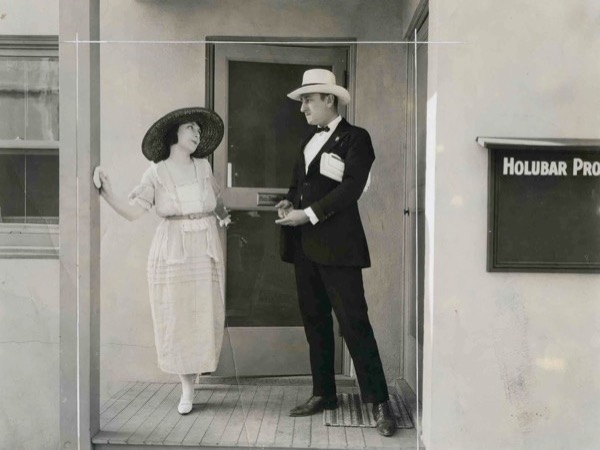THE RIGHT TO HAPPINESS
(Kinderen van een vader)
Allen Holubar (US 1919)
A German officer hurling a baby out of a window – the scene with which Erich von Stroheim shocked post-war audiences in Allen Holubar’s Heart of Humanity (1919) – is really all we insiders know about this director. Outside our circle, he is totally forgotten. This is partly due to his early death in 1923.
One of Holubar’s cameramen, Byron Haskin, thought him a ham, “capable of making the most awful bombs”. He loved action scenes but would get carried away until they became dangerous. Man-Woman-Marriage (1921) involved a battle scene with 450 women playing Amazons. “He was so excitable that when the moment came for him to shout ‘Camera’ he went crazy. ‘EEEEEEEHHHHH!,’ and began shooting off his signal pistol.” Haskin just caught him stepping from the high camera platform into thin air. However, Grant Whytock, Rex Ingram’s editor, admired Holubar and thought he might have developed along similar lines.
Holubar was an ambitious and skilful picture-maker, strong on melodrama, a sort of roadshow Cecil B. DeMille. Like a few directors of our own time, he tended to select complex themes which sometimes proved beyond him.
Born in 1890 in San Francisco, he began his stage career at the age of 16 with the Alcazar Stock Company and played for Belasco on Broadway. When he joined Universal in California he was still in his 20s, and press agents promoting his first picture had him writing, directing, and even playing three roles (unconfirmed!). When he decided to concentrate on direction, he starred his wife, Dorothy Phillips (1889-1980), in each of his films. A stage actress, she had made her screen debut at Essanay in Chicago and was so versatile she was publicized as the Sarah Bernhardt of the Screen.
Holubar chose a pioneer special effects man and a director himself, Norman O. Dawn, to work with his camera team. Dawn is credited with the invention of the glass shot. One remarkable technician trained by Holubar was his assistant director, Reaves Eason, who caught his enthusiasm for action sequences and would direct (brilliantly) the chariot race in the 1925 Ben-Hur.
Among the curiosities in my collection is a 1922 fan letter from an enthusiast in India: “Heart of Humanity can never be sufficiently praised. The whole is a high-water mark in film achievements.” Alas, he had not seen this one, but he considered Man-Woman-Marriage “like a divine flash from an anvil on the forge of Cinema Art”. Motion Picture Classic went so far as to describe Man-Woman-Marriage as better than H. G. Wells’s Outline of History!
1919 was the year of the Red Scare, when Holubar exchanged the Hun as villain with the Bolshevik, in one of the many political films that appeared just before the movies rejected “message pictures” and embraced the Jazz Age. Although The Right to Happiness was hailed by Universal as one of the most spectacular photoplays of the year, it was deplored by Variety: “There is about the production a cheapness that somehow gets into every scene. The story is unconvincing, dripping with crude sentimentality. The camerawork in mediocre.” But Photoplay acknowledged it as “a photoplay of the moment, indeed… [Holubar] asks the working man a question: which will you have in this country to better your condition – destruction under the red flag, or construction and co-operation under the American flag?”
Holubar wrote the story with Olga Linek Scholl, who had co-authored Heart of Humanity. They ensured that audiences realized the savagery of the Cossack pogroms. In their tale of two small girls – sisters without knowing it – they showed one girl, Vivian, being saved by her father, an American businessman living near the Jewish quarter of St. Petersburg. He takes her home to America and mourns the other girl, Sonia. Rescued by a poor Jewish family, Sonia becomes a Bolshevik agitator, despatched by “Lenine and Trotsky” to foment unrest in America. In a coincidence of Dickensian proportions, she foments it in her father’s factory without knowing who he is. Dorothy Phillips played both parts.
Despite the hokum, the film was not an anti-Bolshevik hate picture. It was unique in presenting not only good and bad Capitalists but good and bad Communists. This caused opposition; the Ohio censors recalled the film twice when it played in Cleveland and demanded that “objectionable subtitles” be removed. Universal publicized it as “The Greatest Love Story Ever Told” and the public liked it. The reaction of one exhibitor was printed in the ads: “We had throngs of eager patrons in front of our box office exceeding our greatest expectations.” A fan magazine declared, “We will have more photoplays on this subject. Because it is the biggest cloud in our skies today.”
Three months after the premiere, William Stowell, the actor who played the foreman Tom Hardy, was killed making an expedition film in the Belgian Congo on which he doubled as cameraman and director. Margaret Mann (Mother Hardy), shot to fame briefly when John Ford “discovered” her for Four Sons in 1928.
Kevin Brownlow

asst dir: Reaves Eason.
sogg/story: Allen Holubar.
scen: Allen Holubar, Olga Linek Scholl.
photog: Henry Harris, Al Lathem, Norman O. Dawn.
cast: Dorothy Phillips (Sonia/Vivian), William Stowell (Tom Hardy), Robert Anderson (Paul), Henry Barrows (Hardcastle), Winter Hall (Forrester), Margaret Mann (Mother Hardy), Stanhope Wheatcroft (Monte), Alma Bennett (Lilly), Hector Sarno (Sergius), Maxine Elliott Hicks.
prod: Universal Film Mfg. Co., Jewel Productions.
uscita/rel: 30.08.1919 (NY première).
copia/copy: 35mm, 1469 m. [= 4819 ft.] (orig. 8 rl.), 71′ (18 fps), col. (imbibito e virato/tinted & toned); did./titles: NLD.
fonte/source: EYE Filmmuseum, Amsterdam.
Preserved in colour in 1991 at Haghefilm through an internegative.


 Italiano
Italiano